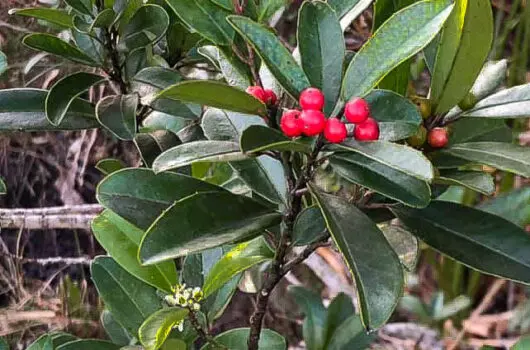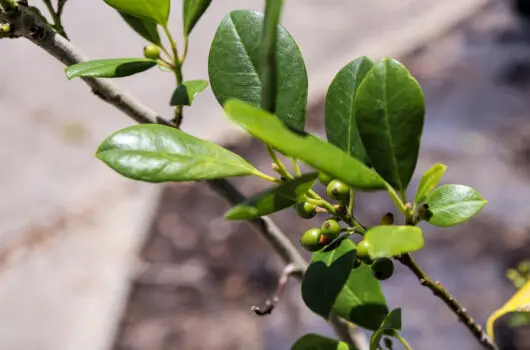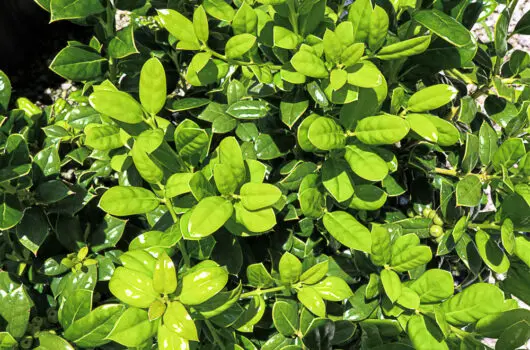by Amanda Rose Newton
While hollies become center stage around the holidays, there are many reasons to celebrate them year-round. Between the shiny foliage and beautiful bright berries, hollies can stand out no matter what the rest of the landscape has chosen to accessorize itself with.

Since they are not deciduous, they keep their leaves on all year and give a sense of predictability and status to your yard. Versatility is part of their norm, with the ability to be a statement plant or to blend in seamlessly as an accent.
Wildlife lovers will appreciate hollies as their year-round roughage provides safe shelter for small mammals and the berries reward birds of many species. They also happen to be sturdy and hold up well against our seasonal hurricanes.
There are three species that are native to Florida, and have a rich history intertwined with early settlers and indigenous peoples.
Lifestyles of the Dioecious
Hollies are dioecious and if you are unfamiliar with that term, it references plants that keep their flower sexes separate. That means when you buy your holly at the garden center, it either has male or female flowers, not both. Hollies are not the only plants that are popular in Florida (looking at you, papaya and dogwood) that fall under this category, but due to their understated flowers, this fact can slip by the uninformed. Female flowers are the only ones to turn into a fruit, which is why you are most likely to come across girls at your local nursery.
Berries are in high demand, and not just for the birds! Both males and females produce white flowers which rely on bees for pollination, with a few flies and beetles serving as backup.
Bees are the long-haul truckers of the bunch, moving pollen up to 2 miles to reach a neighboring female flower. This means you do not need a male right next door in order to secure future production.
Planting Your Holly
Hollies do best in slightly acidic soil, which can be generated with a nice blanket of pine bark mulch. They can be planted at any point in the year and the hole should be about a foot wider than their root ball diameter.
Once planted, the soil should be watered to allow it to settle around the roots. Be careful not to pack the mulch (if using) too tightly around the trunk. It should be loosely applied at the base to allow for steady airflow.
It will take a good 6 months for your tree to establish. To ensure success, it is recommended you follow our watering guidelines for new plantings. Remember, water it every day the first two weeks and then start tapering off a few days the next two, and so on. You may fertilize your tree with a slow-release fertilizer like Espoma Hollytone, which will also lower the pH of your soil naturally.
Pruning Your Holly
The shape of our native hollies is part of their appeal, and you can continue to achieve this through yearly pruning. Think of it as a light haircut each year just to maintain form. If you want to propagate your holly, tip cuttings are usually the way to go. Cuttings should be no more than 5 inches and will need to be treated with rooting hormone. A humid environment is needed to minimize water loss and tissue drying out.
Holly Pests and Diseases
Hollies hold up well to pests and disease pressure but occasionally can have issues with a few. Scale, leafminers, and mites feed on holly tissue and a severe infestation can be problematic. All of these guys can be hard to find, and your best bet is to check under leaves or for the black sooty mold that grows in the secretions left by the pests. Leafminers will leave white tunnels throughout leaf tissue and mites may cause a silvery hue to represent the leaves.
Diseases like twig dieback and root rot are rare and can be fixed with a fungicide if caught early. Witches broom (Sphaeropsis tumefaciens), however, is fatal and is noted by numerous galls (enlarged stems) which produce a broom-like growth of new stems. Usually, this can be avoided by sterilizing pruning tools to reduce infection spread.
Native Florida Hollies
Dahoon Holly (Ilex cassine)– with a height of 40’, this pyramid-shaped tree has shiny green leaves and red berries. This is a great choice for yards with wet soil.
Yaupon Holly (Ilex vomitoria)- a smaller holly trained to take on a weeping habit. The leaves can be used to prepare yaupon tea. The yaupon has the distinction of being the only source of caffeine in the United States!
Eagleston Holly (Ilex x attenuata)- The Eagleston is pyramidal in shape with softer spines and bright red berries. Tall and majestic, this is a great statement tree.

Inkberry (Ilex glabra)- The inkberry takes the form of a medium shrub, with a max height of 10 feet. It is vase-shaped with black fruit and is great for wet areas.

East Palatka (Ilex x attenuata)– This medium-sized tree is like the Eagleston, with a more triangular than pyramidal shape. The leaves are a slightly duller green and tend to be more insect and fungal-resistant.


